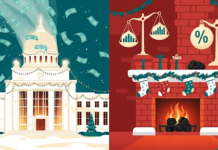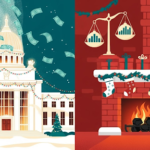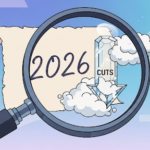This week, the financial world is buzzing with one question: Will the Federal Reserve go for a modest 25 basis point rate cut, or will they pull the trigger on a bold 50 basis point cut? The uncertainty has sent analysts, investors, and traders alike into a tailspin. But the real debate isn’t just about the numbers; it’s about how the markets will react. Would a larger cut be seen as a sign of the Fed’s confidence in controlling inflation, or will it ignite fears of a deeper economic malaise?
This week’s edition of The Market Pulse digs into the heart of this dilemma, where market sentiment, corporate earnings, and potential recession risk are all in play. The Fed’s rate decision could either calm the storm or send tremors through an already jittery stock market.
In today’s newsletter, we’ll explore the latest developments in the Fed’s decision, and more importantly, what it could mean for your investment strategy moving forward. Plus, in our “This Week I Learned” section, we’ll cover why a larger-than-expected rate cut isn’t always the golden ticket investors hope for. Don’t miss The Fun Corner for a light-hearted take on how rate changes are like trying to predict the weather—always uncertain, and often surprising!
Now, let’s dive in and see what this pivotal moment means for investors in the coming weeks.
This Week I Learned…
Why a Jumbo Rate Cut May Not Be the Magic Fix
This week, I learned that bigger isn’t always better—at least not when it comes to Federal Reserve rate cuts. A 50 basis point cut might sound like a welcome gift to investors, especially those concerned about slowing economic growth. But history tells us it’s not that simple.
Large rate cuts are often seen as a sign of underlying trouble in the economy. Take, for example, the January 2001 cut during the dot-com bust or the September 2007 cut just before the financial crisis. Both times, the Fed slashed rates by 50 basis points to ease pressure on the economy, but the results were less than reassuring. Big cuts often lead investors to wonder what the Fed knows that they don’t, sparking fears of hidden risks lurking in the background.
This isn’t to say that a jumbo cut is always bad news. If paired with clear communication about future rate paths and economic stability, it could calm nerves. However, if the Fed opts for a larger cut, investors might want to ask: Are we bracing for impact?
The lesson here? When it comes to interest rates, size matters—but so does timing and context. As investors, it’s crucial to look beyond the headline numbers and consider the bigger picture. Is the economy really in trouble, or is the Fed just getting ahead of potential risks? That’s the key question as markets brace for Wednesday’s decision.
The Fun Corner
Rate Cuts and Rainy Days
Ever try to plan your weekend around a weather forecast, only to end up surprised when a sunny day turns into a downpour? That’s a bit like the stock market’s relationship with the Federal Reserve’s rate decisions.
Imagine the Fed as the meteorologist. A 50 basis point cut? That’s like predicting a storm—everyone preps for chaos, but sometimes the clouds clear unexpectedly. And a 25 basis point cut? That’s like a forecast for light showers: no one’s panicking, but they still grab an umbrella just in case.
Of course, in the markets, as in weather, nothing is ever certain. Even with all the data, models, and forecasts, sometimes the Fed’s moves end up feeling like trying to predict rain in a desert: it either happens or it doesn’t—often leaving everyone scratching their heads.
The best advice? Pack your umbrella, but hope for sunshine! After all, even when the forecast calls for turbulence, things have a way of turning out better than expected—sometimes.
Will the Fed’s Next Move Calm or Rattle Markets?
All eyes are on the Federal Reserve this week, as its upcoming rate decision could send ripples through the stock market. The key debate? Whether the Fed will opt for a standard 25 basis point rate cut or deliver a more aggressive 50 basis point cut. The implications of this choice extend far beyond the immediate market reaction, as it may shape investor sentiment and economic outlook for months to come.
Historically, large rate cuts have been associated with economic crises. The 50 basis point cuts in 2001 and 2007 were signs of deep trouble, from the dot-com crash to the housing market implosion. So, naturally, investors are wondering: If the Fed opts for a jumbo cut, is it a signal that they’re seeing something we aren’t?
But this time around, things are a bit different. Inflation has fallen, and the Fed has room to cut without fear of stoking inflation. The challenge, however, is how investors will interpret the move. A 50 basis point cut could reassure the markets by showing that the Fed is serious about stimulating growth. But on the flip side, it might ignite fears that the economy is in worse shape than it appears.
There’s also the matter of what comes next. A bigger cut now might mean fewer cuts in the future, which could temper market enthusiasm. As we await Fed Chair Jerome Powell’s guidance on Wednesday, it’s clear that the direction of rates is down, but how fast and how far remains uncertain.
For investors, this week’s decision is about much more than a single rate cut. It’s a litmus test for the Fed’s confidence in the economy—and the market’s confidence in the Fed.
The Last Say
Rate Cuts, Risks, and Rewards
As we wrap up this week’s edition of The Market Pulse, it’s clear that the debate over a 25 or 50 basis point rate cut has put markets on edge. Will a larger cut boost investor confidence, or will it spark fears of a deeper economic slowdown? The truth is, the Fed’s decision will have lasting impacts not just on immediate market moves, but on how investors view the trajectory of the economy.
At the end of the day, the direction of travel is clear: interest rates are headed lower. But what matters most is how fast and how aggressively the Fed will move. For now, investors are left to weigh the risks and rewards of this uncertain moment. Is it time to lean into the market, or is caution the wiser path?
Stay sharp, and remember: sometimes, the best strategy is to keep one eye on the forecast and the other on your portfolio.

























